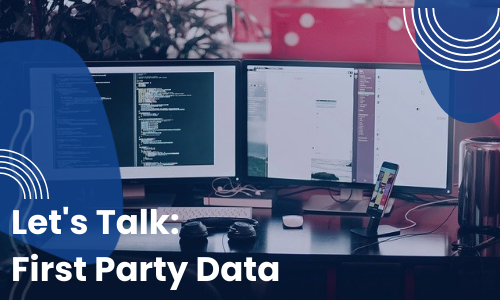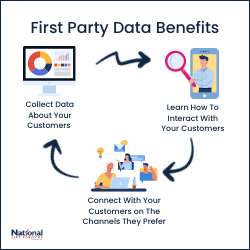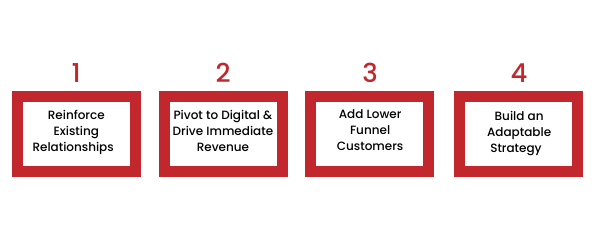Let’s Talk First Party Data

We talk about First Party Data a lot. What it is?
First party data is data that your company has collected directly from your audience which is made up of customers, site visitors, and social media followers. “First party” refers to the party that collected the data firsthand.
First Party Data is collected from the people you have the most to learn from: your current customers! That makes the data as reliable as possible.
How can you collect first party data?
You can attain first party data from your CRM, surveys and subscription-based emails or products. This is also where Google and Social Media Analytics are important.
Google Analytics has a massive list of capabilities and ways to track website data. Using tracking code, Analytics collects information about the way the website was used.
Such as:
- Time of visit
- Pages viewed
- The time spent on each page
- What browser and OS are being used
- Referring site details
- Network location and IP address.
This information can help you see where (and how) traffic is following to and through your website. Google Analytics also has a lot of other tools such as URL Builder that make it easier to track customer data.
Social media analytics are helpful for flushing out the demographics are your most engaged customers. What can you learn about customer from social media? Here’s are some things you can learn:
- What platforms your customers prefer to engage on
- What content do your customers enjoy most
- What type of campaign or advertising works for them?
- Do they have any other hobbies or interests?
- More specific customer demographics, such as age or gender
It’s also super important to connect as many touch points to your customers as possible. The more ways you have to interact with the customer the more likely they are to become a repeat loyal customer. Think about the companies you follow on social media. Have you bought from them? More than once? Are you loyal to them? Do you agree with their mission and goals? Following companies on social media feels like a personal one-on-one connection and generates loyalty.
Organization is Key
The next step of having/using first party data is organization. Having important information about your customers and leads doesn’t do much good if you can’t find it or if it’s connected properly. No matter what size your business is, having a CRM is key. The days of using a Rolodex are long gone. Now there a lot more channels of data to connect to a contact.
For example, in our CRM we keep track of more than just name, company, phone, and email. Our CRM keeps track of what social media we are connected on and any times the contact has engaged with us. We have it set up so that the CRM assigns a number value to actions a contact or lead can take, such as opening emails, clicking links, liking a post, and any orders.
How does all that information benefit us?

There are many ways! For one, we can use the information we have to target or retarget contacts, leads, and prospects. We can try different channels and types of touches until we find which one they respond best to. Having more than one channel connected to each contact makes multichannel campaigns possible.
The other advantage to First Party Data is that you can collect data and analytics about your customers from the channels you are using to constantly to learn more about your demographics and your customer’s buying habits. The more channels you use the easier it will be to learn about your customer. Then the more customers you have the more information you can learn about your potential target audience. You can use a Look-A-Like to build a list of potentials you can target based on information on your current customers.
What ways do use First Party Data?
Here’s how First Party Data might the key to the future cookie-less world.
The 4 Keys To Success In This Environment

We know all the ways things have changed this year. We also know how much trends ,such as relying on digital marketing channels, has sped up. It makes us wonder what we can do to survive and adapt with these changes. Here are four keys to success.

- Reinforce existing relationships. Which means reaching out and keeping in contact with existing and previous customers. Email and social channels are a great way to do this. Having up to date email and other information in your CRM is therefore, critical. Personalizing messages can help you stand out. It’s also important to figure out what channel your customers prefer to buy from you. Compare the current channels to what they preferred before this year to see the direction you should be focusing.
- Pivot to digital and drive immediate revenue. Without money coming in, it’s very hard to build a strategy for the future. Therefore, make sure your team and any tools or tech you need is ready to go.
- Acquire lower funnel customers. A lot of customers now are skipping the “passing interest” phase. They do research, find you, then buy. Making it easy for customers to find you when they are looking is important. Capitalize on lower funnel customers by knowing exactly how they got to you. One way to do that is by utilizing Pixel data. (Want more information on Pixels? Click here.)
- Position for success as this reverts back to “normal.” Have a plan. One thing to think about when building your plan is to create structures with the shifts in buying habits shift in mind. Test and experiment with different types of engagement now to see what channels to focus on on the future.
What do you think the key to successfully navigation the new marketing landscape is?
